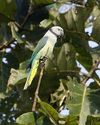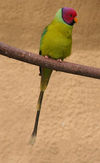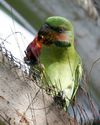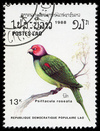Genus Psittacula
Moustached Parakeet - Feral populations of this species have now established themselves in cities like Mumbai and small numbers occur in other cities such as Chennai and Bangalore in India.
Layard's Parakeet - Layard's Parakeet is a green parrot, 29 cm long including a tail up to 13 cm. The adult has a bluish-grey head and back, separated by a green collar. There is a broad black chin stripe and the tail is blue tipped yellow. The upper mandible of the male's bill is red and the lower mandible is brown.
Blyth's Parakeet - The Nicobar Parakeet is classified as Near Threatened by the IUCN. Very little is actually known about its ecology and conservation status.
Malabar Parakeet - They breed in the dry season after the northeast Monsoon and the chicks fledge before the southwest Monsoon in June. They nest in holes in trees, especially old woodpecker and barbet nests. The birds begin breeding in December and eggs are laid in December and January. The usual clutch was 4 eggs which hatch after about 23 days. The female initially broods with the male bringing food and later the male takes over. The chicks fledge in about a month and leave the nest. Chicks are sometimes trapped for trade.
Plum-headed Parakeet - The Plum-headed Parakeet is a mainly green parrot, 33 cm long with a tail up to 22 cm. The male's head is red, becoming purple-blue on the back of the crown, nape and cheeks. There is a narrow black neck collar and a black chin stripe. There is a red shoulder patch and the rump and tail are bluish-green, the latter tipped white. The upper mandible is orangish-yellow, and the lower mandible is dark.
Lord Derby's Parakeet - The name of this bird commemorates Edward Stanley, 13th Earl of Derby.
Psittacula eques - Psittacula eques is a species of Parakeet. There were formally two subspecies, but one, the Réunion Parakeet is now extinct. The extant Mauritius Parakeet is considered endangered.
Alexandrine Parakeet - The species name eupatria has its origins from Latin and/or could be a Greco-Latin combination. Where the prefix eu translates into good or noble and the suffix patria is a Latin word translating into fatherland or ancestry. Consequently, the scientific name means of noble fatherland or of noble ancestry.
Newton's Parakeet - The species epithet exsul, "exiled", refers to the refugee François Leguat, who gave the first testimony of the bird. The last living bird was seen in 1875. Only two complete specimens and various subfossil bones survive.
Grey-headed Parakeet - The binomial of this bird commemorates the German naturalist and explorer Otto Finsch.
Rose-ringed parakeet - This non-migrating species is one of few parrot species that have successfully adapted to living in 'disturbed habitats', and in that way withstood the onslaught of urbanisation and deforestation. In the wild, this is a noisy species with an unmistakable squawking call.
Blossom-headed Parakeet - Blossom-headed Parakeet is a bird of forest and open woodland. It nests in holes in trees, laying 4-5 white eggs.
Seychelles Parakeet - It was endemic to Mahé and Silhouette and was once sighted on Praslin. It was rare when described even in 1867. The last specimens were collected by Warry in 1881, and the last birds recorded in captivity on Silhouette in 1883. The species was extinct by 1906.








